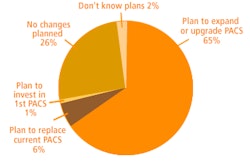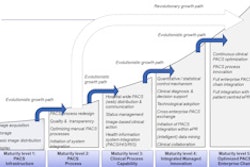Creating a shared diagnostic image repository between PACS sites requires determining whether to allow nonlocal images to be imported or "ingested" into a participating institution's local PACS when needed. The best choice, however, may involve a compromise that relies on a clinical viewer to access repository images.
That's according to the experience of the Southwest Ontario Digital Imaging Network (SWODIN) project in Canada.
"The majority of access to the repository is through the clinical viewer; and then only in cases where you actually need to ingest would you ingest," said Babette MacRae of London Health Sciences Centre in London, Ontario.
She discussed SWODIN's experience during a scientific session at the recent 2010 Society for Imaging Informatics in Medicine (SIIM) meeting in Minneapolis.
Linking Ontario hospitals
A shared image repository is a regional archive shared by multiple healthcare facilities that gives participating sites easier access to patients' prior images and associated reports that are stored at other participating sites, allowing for viewing of their imaging history.
SWODIN aims to create a diagnostic imaging repository capable of housing 4 million imaging exams per year and connecting more than 60 Ontario hospitals with multiple versions of HIS/RIS and PACS. This task involves resolving patient identifiers and displaying a comprehensive patient record, providing business continuity through disaster recovery and failover, adhering to privacy and security policies and audit requirements, and providing a shared-services model to support and maintain the repository, MacRae said.
Several jurisdictions in Ontario are actively engaged in similar projects, and they have encountered a significant number of challenges associated with building these repositories and sharing information, she said. Standards such as the Integrating the Healthcare Enterprise (IHE) Cross-Enterprise Document Sharing (XDS) profile facilitate the sharing of images and reports, but, unfortunately, they have not yet been widely adopted, MacRae said.
"This has also sparked a huge debate in Ontario and other places in Canada whether or not to 'ingest' images [from the repository] into the local PACS," she said.
Currently, the two most common implementation options are either to push images into local PACS through prefetching protocols (ingestion) or to collect all images and associated data into the diagnostic imaging repositories and use a viewing application (attached to a local PACS or as an integrated viewer) to access images in the repository, MacRae said.
Ingestion
In the ingestion model, all images and data from participating institutions are collected into the repository. When an imaging order is placed at a facility, prefetching protocols are triggered to retrieve copies of relevant prior studies from the repository and send them to the local PACS for comparison with current images.
The model of importing nonlocal images into a local PACS leads to a number of issues, including deciding how this movement will occur, MacRae said. For example, the prefetching protocol will need to be determined, delineating details such as how to determine relevancy and how broad the prefetching criteria will be, as well as how they are triggered, she said.
Transmission speed also needs to be considered, and high-volume sites will need to take into account the effects of this model on their local network, she said.
These nonlocal images will also need to be managed in an effective way, navigating issues such as how these images are presented and what is required for hanging protocols, she said.
"One of our big issues is that each PACS implementation and RIS implementation has different procedure codes defined," she said. "So we don't have any consistency, which creates problems if you do try to ingest them."
Other issues include whether an order is required, whether patient identification needs to match, and how an exam is identified as nonlocal, she said. Also, if a system allows dictation of an imported exam, what happens to the report?
If images can be modified by the local PACS, it's important to determine how changes will be communicated back to the repository and to the host system at the originating institution.
Option B
In the second approach of using a viewer to access the longitudinal image set at the repository, the capabilities of the viewer need to be considered to ensure it has proper tools for the radiologists, she said.
Adoption may be an issue, though, especially with the radiologists, she said. "Radiologists are very adamant that they would like to see images from within their local PACS."
It may be possible to launch the repository viewer from within the PACS workstation, however. And response may be improved if a Web-based viewer is utilized, she said.
This model may also make it easier to maintain privacy and security controls as the diagnostic image repository application has full control over access, she said. It also will allow for better control over auditing, as centralized auditing can be performed by the application layer and/or using the IHE Audit Trail and Node Authentication (ATNA) profile to perform user authentication, connection authentication, and audit logging, she said.
This approach also ensures data integrity, as no changes can be made. However, user profile management can be a challenge if Lightweight Directory Access Protocol (LDAP) is not being used, she said.
A consent management service should also be considered; this will require integration with the repository application, she said.
MacRae concluded that in the absence of a widespread option for setting up image repositories, the approach of sending copies of images from the repository to the local PACS leads to a number of data integrity and security risks that must be thoroughly evaluated and understood.
Some of these risks can be mitigated or avoided by using an edge device or by providing image display directly from the repository, she said.
It's also important to understand the clinical audience, according to MacRae.
"We're spending 80% of our effort on 20% of our clinical population, and we're spending 80% of our cost on resolving the rising challenge of importing and ingestion," she said.
By Erik L. Ridley
AuntMinnie.com staff writer
August 11, 2010
Related Reading
Software glitch shuts down VA-DoD EMR data exchange, March 12, 2010
First hospital joins Ontario imaging network, December 17, 2009
MGH's Render app finds images in PACS databases, November 23, 2009
GE lands Ontario archive deal, June 22, 2009
Rhode Island sets off on path for statewide HIT exchange, September 21, 2007
Copyright © 2010 AuntMinnie.com




















